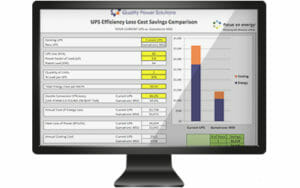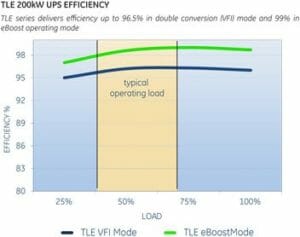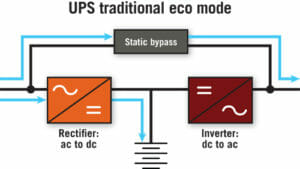
How Energy Efficient is Your UPS System?
When a company is deciding on ideal back-up power equipment for their space, they consider many factors, such as the capabilities of the system, how much the system can grow and expand, and what equipment the system will be supporting. One of the more important aspects of this decision is also the system’s overall efficiency. If your UPS is inefficient, it can end up costing your company time and money if it is not properly designed and utilized. Let’s review the concept of efficiency for UPS equipment, ways that efficiency is measured, and how the resultant data can then be applied to make improvements and realize savings to your UPS system.
Let’s start with measurement. How is energy measured on a UPS? This answer is fairly simple, kWh demand in versus kWh demand out. When looking at input current and output current on typical UPS units, you can see loss from utility input to the output load on the unit. Some energy is always wasted as heat and electrical capacitance, which affects overall efficiency.
We’ve created a helpful calculator that can provide guidance on measuring the efficiency of your UPS system. You can download this for free here!
Aside from system input and output, one of the first things that should be considered regarding UPS efficiency is sizing your UPS unit properly. All UPS units have different efficiency curves, but for most systems, low efficiency often occurs with low utilization. A UPS that has a significant capacity, but is lightly loaded can waste tens of thousands in electrical costs that your company is paying for!

Factors to consider when measuring UPS efficiency are:
-
-
- Design efficiency of the UPS
- Percent load on the UPS. A great UPS model may be running at a low percentage load, which lowers its efficiency.
- Cost of energy per kilowatt hour (kWh). The higher the cost, the more effect UPS inefficiency has on the company’s bottom line.
-
In addition, reducing utility load can provide potential tax or other credit incentives. Some local power companies or organizations like Focus on Energy may offer credits for a reduction in consumption.
It is also important to look at efficiency ratings on your UPS system in various modes of use. Two common modes are a true online mode and eco mode or ESS mode.

True Online mode: The UPS continuously generates the output voltage through double conversion of AC to DC power and back to AC.
Eco mode: The load is normally in a bypass path, allowing the raw utility to supply the load, and the UPS inverter is only engaged when the main utility fails. In eco mode, the UPS inverter is operating in a “standby” mode. The absence of the inverter allows for a more efficient path for electricity, but little protection if the utility power is not ideal or conditioned.
So how should you use the data gained by measuring energy efficiency? The data found from these measurements can help with numerous decisions about your UPS, which can include:
- Replacing an aging UPS versus continuing to repair it, as repairs can become costlier over time
- Resizing a UPS that is not properly loaded, to reduce space, heat, and electricity costs
- Investing in a more efficient UPS to save money through tax credits
- Possible reduction in cooling
- Amount of time to pay back equipment investment
All of these decisions are beneficial, either saving you time, space, or money that you can reinvest back into your business.
Measuring efficiency can be complicated if it is not a routine practice for you. The technical experts at QPS can help with analysis of your load, size, energy cost, and energy usage to come up with a solution that makes sense for you. Contact QPS today to learn more.
Published on Jul 02 2019
Last Updated on Jan 25 2023